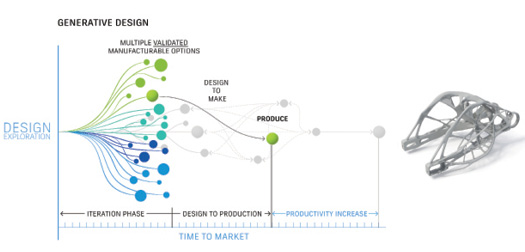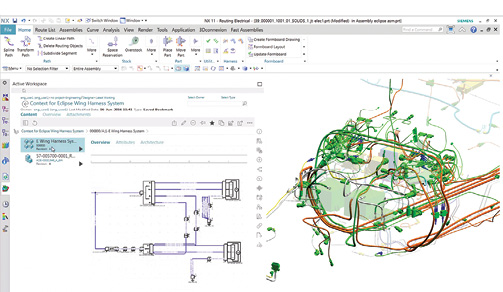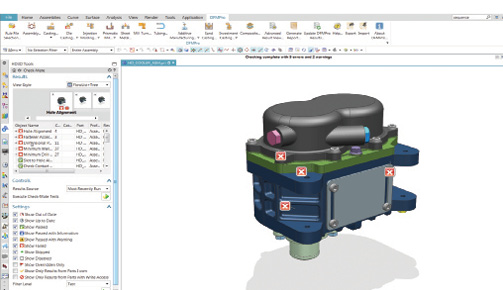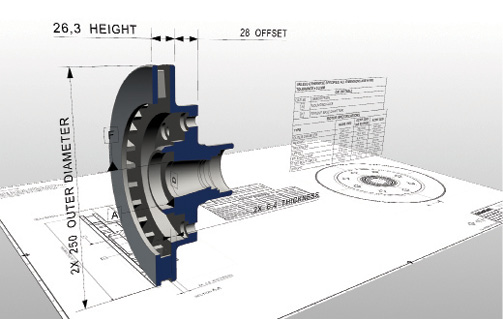Developing machines for the Industrial Internet of Things (IIoT) requires engineers to bring the physical and digital worlds together on the shop floor to an extent rarely seen before. This involves incorporating a greater number and variety of components and subsystems into the machinery. Designers also must contend with more sophisticated issues, as well as accept the increased complexity of the design process. This means that engineers will have to work differently, adopting new design methodologies and tools to succeed (Fig. 1).
Things Are Getting Complicated
A close look at the IIoT reveals dynamic forces at work in the new industrial landscape, and offers a glimpse of the scale of changes at hand. Plant managers now expect machinery to be more connected—to plant operations systems, individual production lines, customers and original equipment manufacturer services. At the same time, users want greater functionality and smarter interfaces.
To implement these features in machinery, vendors offer a staggering assortment of devices and technologies. This wealth of options offers designers significant advantages, but it can also become a burden.
“Advancement is occurring at such a rapid rate right now that keeping up with new technologies and new uses for technology is becoming very difficult,” says Richard Wand, president of MJ Engineering, a custom machine and system design consulting firm. “We rely heavily upon distributors that sell the equipment, but selling the equipment is completely different from integrating the equipment and making it useful.”
When evaluating their technology options, engineers may want to consider how the device or system will facilitate the use and management of data. “The next generation of industrial machines connected to the IIoT will create a lot of data,” says Ahmad Haidari, global industry director of process, energy and power at ANSYS. “Designers must contend with what to do with all that data—determine what is important, what to collect and what data to keep.”
Although the growing availability of data and the emergence of pervasive connectivity open the door for great advances in machine design, these factors also force designers to confront a new class of challenges. Prominent among these is the need to implement robust security.
Previously, a machine might have had limited communications capabilities. Now, the introduction of network communications not only allows designers to translate big data into IIoT benefits, but it also makes plant data and operations vulnerable to cyberattacks. As a result, design teams have begun to use industrial security assessments and a raft of other tools to aid in implementing proactive cybersecurity.
All these factors have affected machine design, but the IIoT has brought an even more fundamental change to the process. “The design phase of machines has evolved beyond the traditional serial procedures,” says Thomas Sugimoto, Workbench software product marketing manager at Rockwell Automation. “In the past, the design process was linear. With connected design tools, engineers are less reliant on serial procedures and can strive toward parallel development.”
For example, drawing teams can get information from the programming teams on what hardware they require. The mechanical teams can digitally test the designs that the electrical teams have prototyped to provide feedback before the physical build begins.
“As you layer these design phases onto one another not only are problems spotted earlier while the design is flexible, the overall timeline begins to shrink as well,” says Sugimoto. “This parallel development paradigm is enabled by systems that can share information across the digital thread.”
Generative Design Harnesses AI
The demands introduced by the IIoT, as well as market-driven time, space and cost constraints, have forced engineers to adopt design approaches that go beyond traditional methodologies. Generative design attempts to replicate nature’s evolutionary development process by leveraging the power of artificial intelligence.
Using this approach, engineers interact with algorithms to generate and evaluate hundreds of potential designs. The process starts with the engineer inputting into the software the project’s goals and constraints. These can include parameters such as performance or spatial requirements, materials, manufacturing methods and cost constraints. Through an iterative process, the software explores all possible permutations and quickly generates several design alternatives, learning what works and what doesn’t from each iteration (Fig. 2). Current use cases have shown that generative design can reduce part weight by as much as 30% using traditional manufacturing and 70% using additive manufacturing. This approach also promises to enable innovation beyond that which can be achieved with the human mind, providing solutions to complex problems that would be resource-exhaustive with conventional means.

“Machine design is not limited to mechanical CAD any longer,” says Bill Davis, director of the industrial machinery and heavy equipment industry at Siemens Digital Industries Software. “Modeling and simulation go hand in hand, and more engineers in machinery are embracing generative design, which helps build the model through topology optimization by running successive iterations on the simulation model.”
The Best of Both Worlds
Design modularization is another methodology gaining favor. This approach combines the advantages of standardization with those of customization.
Using this practice, design teams subdivide a system into discrete, scalable modules that can be independently created and used in different systems. To ensure interoperability, the engineers incorporate industry standard modular interfaces.
The driving forces behind this approach lie in seemingly mutually exclusive demands. Industrial facilities seek machines tailored to accommodate the unique demands of their applications, such as size, operating speed and specialized features. At the same time, however, plant managers place a high value on flexibility. To further complicate machine makers’ tasks, customers want the machines immediately at the lowest possible price.
To meet these demands, machinery companies turn to modular strategies, making sure each functional area of the machine can be customized while also streamlining the manufacturing process by building similar, more repeatable designs.
Another issue that comes into play—similar to demands for customization—is the almost constant need to modify industrial machinery. In this arena, few operations go unchanged for years or decades. Demands are constantly changing, and the most competitive industrial facilities are those that can capitalize on those changes before their competition. Engineers can implement design modularization to provide end users with this level of agility.
“A modular system allows for changes to be made rapidly with minimal disruption—a new product configuration, a new lot size, swapping a machine or cell out for a more efficient one. All of these are significantly harder without the forethought of modularity in designs,” says Matt Masarik, marketing manager for design software at Rockwell Automation.
Getting Everyone to Work Together
In the quest for shorter development cycles and the pursuit of parallel development streams, design software vendors and engineers alike inevitably come to the nagging question: How can design teams get the various engineering disciplines to work together efficiently? The IIoT’s drive to incorporate greater sensing, connectivity and intelligence in individual devices and machines only adds to the urgency of solving this dilemma.
The real issue boils down to one element: communication. One way to improve design team interaction is through the tools that engineers use. This leads to the next question: What features best facilitate collaboration between all the engineering disciplines that have a stake in the design project?
Some advocate for a high-technology approach. “The adoption of digital twins has taken root because it begins to break down the barriers to these communications,” says Masarik. “Digital testing of a proposed machine design allows the programming team to see how their code functions with the hardware that the mechanical team selected before the machine is built. The digital model allows a designer to walk through the model as if they were on the floor, spotting usability improvements or unanticipated hazards.”
Another school of thought points out the value of simpler technologies. “Many times, non-mechanical team members need machine specifications or layouts before the machine is fully designed,” says Ryan Pinto, senior mechanical engineer at Linx Global Manufacturing, a Chicago-based multidisciplinary engineering consultancy.
“They also may not have computers capable of loading complex 3D models,” Pinto adds. “These models might be unnecessary to answer questions that teammates from other disciplines may have. I feel many underestimate the value of a good 2D vector CAD program. Providing a 2D layout, as opposed to a full 3D assembly of your newly designed or in-progress equipment, would be quicker, require less data and possibly protect intellectual property if you were working with third-party contractors.”
The solution to getting all disciplines to work together may involve both approaches. One thing, however, is clear. When looking for a design tool that supports cross-discipline collaboration, the tool and supporting data structure must be able to relate in a way that the design elements can be identified in all the different domains, something called cross-probing (Fig. 3).

New Methodologies Require New Tools
Increased reliance on methodologies like generative design, modularization and multi-physics engineering has inevitably led to a new generation of modeling and simulation tools. These offerings aim to dramatically shorten design cycles by providing greater flexibility, streamlining workflows and increasing the efficiency of data manipulation and translation. The result is a design process that looks very different from traditional approaches.
“The design process of the future requires a connected experience, where data moves seamlessly through a digital pipeline and can be accessed anywhere during product development,” says Vik Vedantham, senior manager of Fusion 360 business strategy at Autodesk. “Contextual representation of information pertinent to rapid decision making is critical to minimize non-productive time. Engineers don’t have the time to learn in-depth workflows. Hence, the solution needs to have built-in automated routines so that the user can accelerate through the design process.”
These smart features are not new; in the past, however, the algorithms that powered them typically were complex mechanisms with challenging interfaces that required operators to have special training. The latest generation of design tools aims to remove this obstacle by providing simplified front ends and greater ease of use.
“As the landscape shifts, engineers will be able to take advantage of automated routines for optimization and leverage intelligent techniques to explore the design space during the ideation phase (Fig. 4),” says Vedantham.

Another way to accelerate development cycles is the use of early-stage validation tools. This practice allows engineers to identify problems and trends throughout the design process, evaluate the various design concepts and then perform detailed simulations of the critical parameters using design optimization tools.
The efficiencies promised by the latest generation of tools also address the need for greater integration of multi-domain design processes. “Design tools not only need to incorporate conventional modeling approaches but need to combine modeling paradigms that build different model types than conventional surface models,” says Siemens’ Davis. “You also need to be able to bring simulations from multiple disciplines, such as thermal and fatigue, into the design. So having a tool that can run all these simulations and optimize the design is very powerful.”
Turning to the Cloud
The enhancement of design tools with new, sophisticated technologies promises to help design engineers meet the demands of the IIoT, but the advancements come at a price. Design teams increasingly find themselves in need of greater compute resources. As methodologies such as generative design and multiphysics play greater roles in the design process, the number of parameters increases, and so do the permutations of simulations that engineers must perform to finalize a design. As a result, technologies like parallel computing have come into play.
One way design tool providers have sought to meet these demands has been to take advantage of recent trends in cloud computing.
“The cloud presents an opportunity to bring together ecosystems to encourage collaboration, take away the burden of data manipulation and translation, house powerful algorithms that can automate much of the mundane work and deliver higher horsepower for multi-domain simulation,” says Vedantham. “For example, built on the cloud-based Forge platform, Fusion 360 is able to bring together design, validation, data management and manufacturing workflows while also presenting powerful and intelligent automation algorithms like generative design to help engineers accelerate innovation and increase productivity in machine design.”
Making Things Easier
Not all efforts to tailor modeling and simulation tools for the IIoT increase the software’s complexity. As the developers of these tools incorporate enhancements, they also recognize that designing a next-generation IIoT machine should not require a significant investment in time by the designer. The fact is that design engineers often value ease of use—and shorter design cycles—as much or more than some advanced capabilities.
“I would consider sacrificing some functionality if the ease of use is there,” says MJ Engineering’s Wand. “The less time I have to spend training people how to use the software, the shorter our learning curve. And in this tight job market, that can be very important.”
About the Author
Follow Robotics 24/7 on Linkedin
Article topics
Email Sign Up
















